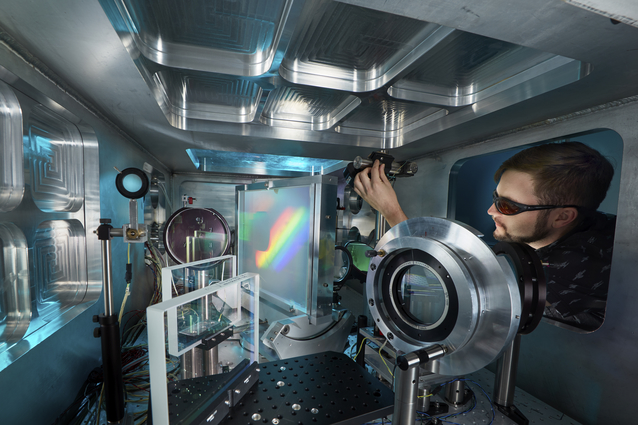LLNL’s Jupiter Laser Facility funding renewed for additional research in discovery science
 (Download Image)
(Download Image)
Austin Linder from the Jupiter Laser Facility works on aligning the COMET laser system for user experiments.
The Department of Energy’s Office of Science recently announced $28.5 million for LaserNetUS to advance discovery science and inertial fusion energy.
Lawrence Livermore National Laboratory (LLNL) is one of nine facilities operating high-intensity, ultrafast lasers that will receive additional funding.
LaserNetUS is North America's high intensity laser research network which provides open and free access to researchers from the U.S. and abroad and enables students to conduct work for their dissertations. The LaserNetUS facilities are located at universities and national laboratories distributed geographically throughout the U.S. and Canada. The network currently has more than 1,200 members.
“LaserNetUS has been extremely successful in providing opportunities and capabilities that were largely unavailable to the broad community prior to the formation of this network,” said Jean Paul Allain, associate director of Science for Fusion Energy Sciences (FES). “In this new phase, the network will play an important role in advancing inertial fusion energy in addition to discovery plasma science.”
Projects funded in this announcement will explore astrophysics and planetary science, laser-produced plasmas, laser wakefield acceleration, EUV lithography, cancer radiotherapy with laser-driven radiation, radiography and tomography, materials science and inertial confinement fusion.
LLNL’s Jupiter Laser Facility, which has been part of LaserNetUS since its inception, was renewed for three more years for research in discovery science and inertial fusion energy.
“This is a great opportunity to provide unique capabilities to the scientific community and advance high energy density and inertial fusion energy sciences,” said Félicie Albert, the project principal investigator, who will assume the directorship of the Jupiter Laser Facility next month.
LaserNetUS was established by the FES program in response to a recommendation from the National Academies of Sciences, Engineering, and Medicine report, “Opportunities in Intense Ultrafast Lasers: Reaching for the Brightest Light.”
The projects were selected by competitive peer review under the DOE Funding Opportunity Announcement for LaserNetUS for discovery science and inertial fusion energy. They will last up to three years, with total funding of $28.5 million: $11.4 million in FY23 and $17.1 million in outyear funding contingent on congressional appropriations.
The list of projects and more information can be found on the FES program website.
Contact
 Anne M. Stark
Anne M. Stark
[email protected]
(925) 422-9799
Tags
Jupiter Laser FacilityLasers and Optical S&T
Lasers
National Ignition Facility and Photon Science
Physical and Life Sciences
Featured Articles







